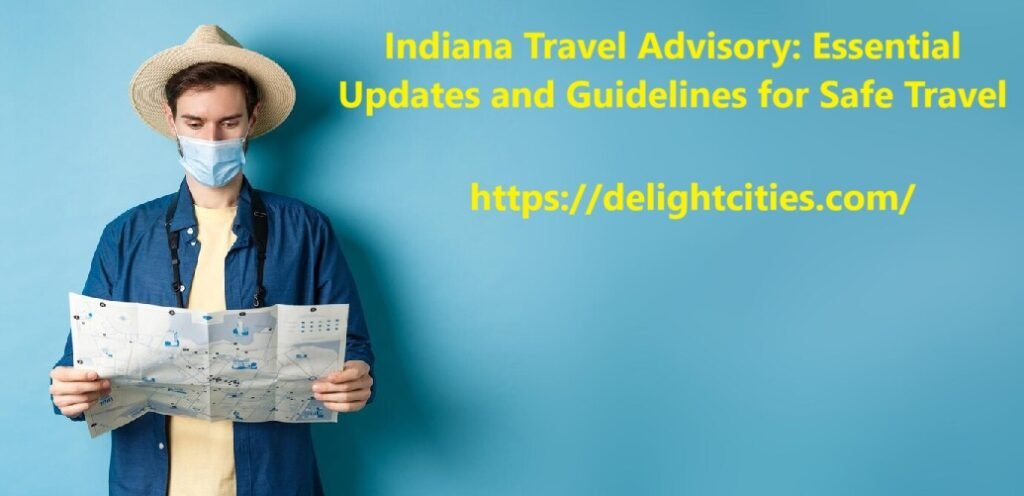Indiana Travel Advisory: Essential Updates and Guidelines for Safe Travel

Indiana Travel Advisory
Introduction
Traveling to Indiana? Whether you’re a resident or a visitor, staying updated on travel advisories is essential for ensuring your safety and making informed travel plans. Indiana travel advisories can encompass various conditions, from severe weather to health and safety restrictions. In this article, we’ll provide a comprehensive guide on what you need to know about Indiana Travel Advisory, including how to stay informed, the types of advisories you might encounter, and tips for safe travel across the state.
What is an Indiana Travel Advisory?
A travel advisory is an official notice issued by state or local authorities to inform the public about potential risks or disruptions that could affect travel. In Indiana, advisories may be issued for various reasons, including severe weather, road conditions, public health emergencies, or specific safety alerts. Travel advisories are usually categorized into levels based on severity, guiding residents and travelers on how to respond and what precautions to take.
Types of Indiana Travel Advisories
- Weather-Related Advisories
- Severe weather conditions are a common reason for Indiana travel advisories. In winter, snow and ice storms can make roads dangerous, while heavy rains and thunderstorms in other seasons may cause flooding. Tornado warnings, which are also common in the Midwest, require extra precautions.
- Weather-related advisories often provide details on expected conditions, advice on road closures, and updates on which regions are most affected. Indiana’s Department of Homeland Security (IDHS) monitors weather patterns and issues warnings accordingly.
- Health and Safety Advisories
- Health advisories may be issued during flu season or public health emergencies like pandemics. They often include guidance on vaccinations, recommended or required health practices, and information about mask mandates or other protective measures.
- In addition to health-related updates, safety advisories may be issued for specific events, festivals, or situations that could impact public security, such as large gatherings or protests.
- Traffic and Road Conditions
- Travel advisories related to road conditions are essential for those driving through Indiana. Construction, road closures, or detours can create significant delays. Indiana maintains an updated road information system where travelers can check current road conditions before heading out.
- Event-Specific Advisories
- Indiana is known for hosting popular events like the Indianapolis 500 and various fairs and festivals. During these events, travel advisories may be issued to manage crowd control, address traffic congestion, and ensure the safety of attendees.
Indiana Travel Advisory Levels and What They Mean
Indiana uses a color-coded travel advisory system, commonly displayed as a map on the IDHS website. The advisory levels are typically classified as follows:
- Advisory (Yellow): The lowest level, signaling caution due to minor road or weather conditions. Travelers are advised to remain vigilant.
- Watch (Orange): Moderate caution is advised, with certain activities potentially restricted. This level often indicates deteriorating road conditions or mild to moderate weather issues.
- Warning (Red): The highest advisory level, issued in severe situations where travel is discouraged or only allowed for emergencies. Conditions at this level can be highly hazardous, requiring careful planning and preparation.
These levels help the public gauge the severity of conditions and make informed travel decisions based on real-time updates.
How to Stay Updated on Indiana Travel Advisories
1. Check Local Government Websites
- The Indiana Department of Homeland Security (IDHS) provides real-time updates on travel advisories, which can be accessed on their official website. The IDHS interactive travel map shows county-level advisories, giving a clear picture of which areas are most affected.
2. Download the Indiana Travel Advisory App
- IDHS offers a mobile app that provides instant notifications on advisories. By downloading the app, travelers can receive push notifications on travel restrictions, weather alerts, and other critical updates, making it easier to adjust travel plans accordingly.
3. Use National Weather Services
- For weather-specific advisories, the National Weather Service (NWS) provides detailed information on storm warnings, snow conditions, and other severe weather patterns in Indiana.
4. Sign Up for Emergency Alerts
- Many Indiana counties offer emergency alert services that notify residents and travelers about severe weather, traffic incidents, or other local emergencies. Sign up for these alerts to stay informed, especially if you’re planning long-distance travel or visiting multiple regions within Indiana.
Preparing for Travel in Indiana: Tips and Best Practices
- Plan Ahead for Seasonal Changes
- Indiana experiences a range of seasonal weather, from heavy snow in winter to hot and humid summers. Check the forecast before your trip, and prepare accordingly. Pack emergency kits for winter travel and ensure your vehicle is equipped for potential weather hazards.
- Stay Updated on Health Regulations
- During flu season or in times of health emergencies, stay informed about health regulations. This may include mask mandates, vaccination requirements, or restrictions on gatherings, especially if traveling to or from areas with high transmission rates.
- Adjust Your Itinerary Based on Events
- Large events, such as the Indianapolis 500 or college sports games, can lead to crowded roads and increased security measures. If your travel dates coincide with major events, plan extra travel time and check for advisories related to road closures or heightened security.
- Follow Local News Channels and Social Media
- Local news channels often report travel advisories as they develop. In addition to the IDHS, social media accounts from local authorities and news stations are also excellent resources for quick updates.
What to Do If You Encounter an Advisory While Traveling in Indiana
- Stay Calm and Follow Instructions
- If you receive an advisory notification while traveling, remain calm and assess the situation. Adhere to official instructions, such as avoiding certain roads or following detour signs. Avoid taking unnecessary risks, especially if road conditions are hazardous.
- Contact Local Authorities If Needed
- In severe situations, such as being stranded due to road closures or encountering severe weather, contact local authorities or the Indiana State Police for assistance. They can provide guidance on safe routes or, if necessary, dispatch help.
- Utilize Roadside Assistance Services
- Many insurance providers and AAA offer roadside assistance. Keep these contact numbers handy in case of breakdowns or other issues, especially if traveling during adverse weather conditions.
- Have an Emergency Kit Ready
- Carry an emergency kit with essentials such as water, non-perishable food, blankets, a flashlight, and a first-aid kit. In winter, add items like extra warm clothing, a shovel, and sand or cat litter for traction if your vehicle gets stuck.
Frequently Asked Questions (FAQs) About Indiana Travel Advisories
1. What should I do if I encounter a travel advisory while driving?
- Follow official instructions and avoid taking detours not recommended by local authorities. Use GPS navigation to identify alternative routes if necessary, but prioritize safety over speed.
2. How often are Indiana travel advisories updated?
- Travel advisories are updated as conditions change, sometimes multiple times a day, especially during severe weather events. Check the IDHS website or app regularly for real-time information.
3. Can I travel during a “Warning” level advisory?
- Travel during a “Warning” level advisory is discouraged. Only emergency personnel and essential services are advised to travel during these times due to heightened risks.
4. Are travel advisories issued for specific cities in Indiana?
- Yes, advisories are often issued on a county-by-county basis. The IDHS map allows you to view advisories for specific regions, including cities within those counties.
5. Are there penalties for ignoring travel advisories?
- While there may not be penalties for ignoring advisories, it is highly discouraged to ignore safety warnings. In severe cases, local authorities may impose roadblocks to restrict travel for public safety.
Conclusion
Staying informed about travel advisories in Indiana is essential for ensuring a safe journey. By keeping an eye on advisory levels, utilizing official sources like the Indiana Department of Homeland Security, and preparing for seasonal weather changes, travelers can make informed decisions and navigate Indiana’s roads safely. Remember, travel advisories are issued for your protection, so take them seriously and always prioritize safety.
Read More Also: Travel Ban in Erie County




